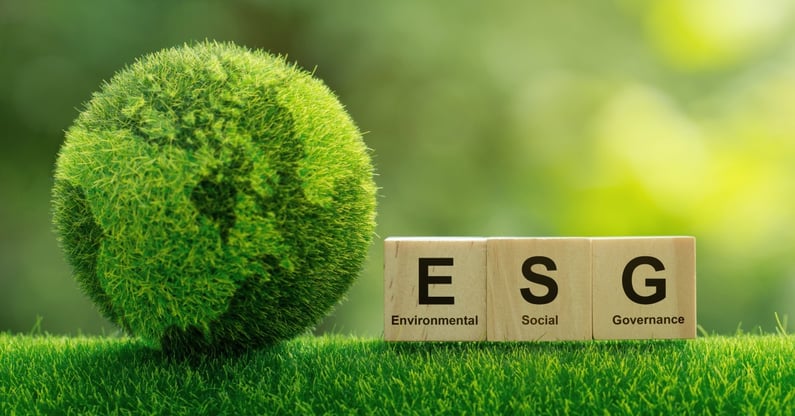The 'E' is currently the giant in the ESG triangle. The environmental revolution and the green transition are megatrends, and in surveys, companies often list the environment as their main sustainability objective. Environmental impacts are managed through common practices, policies, innovation and collaboration.

E is for Environment
The Governance section of the ESG refers to good governance. Social, refers to issues and measures related to human well-being. Environment covers both the protection of nature and its biodiversity and the reduction of the carbon footprint. Climate and conservation of nature are both placed under "E".
The 'E' in ESG seems to be the most popular and preferred letter for many. The environment is perceived as a corporate social responsibility issue that is nicely straightforward and the impact can be measured in numerical data. However, to reduce the footprint, the 'S' and the 'G' are also needed as essential elements.
Social and Environment are often set at odds with each other. However, they are inseparable. The supposed primacy of the environment is defended on the basis of the intrinsic value of the environment and the fact that there is nothing to defend for human rights if there is no planet on which human life can exist. This is absolutely true, but sometimes a tone of whataboutism creeps into the debate. A focus on the environment cannot be a valid reason to leave structures that oppress human rights in place.
It is also often forgotten that man is an animal and that the built environment is a creation of nature, as much as a bird's nest. The very fact that we forget that human beings are part of nature is the beginning of alienation from nature.
E and S are inseparable
By many definitions, nature is a human right. For example, the Constitution of Finland states that:
"Nature and its biodiversity, the environment and the national heritage are the responsibility of everyone.
The public authorities shall endeavour to guarantee for everyone the right to a healthy environment and for everyone the possibility to influence the decisions that concern their own living environment.”
In contrast to the formulation of many other fundamental rights, the right to nature may be presented as a right and a duty at the same time. It is clear that human well-being is strongly linked to the well-being of nature and its diversity, and that human behaviour strongly influences that well-being and diversity.
The private sector plays a huge role in environmental matters and therefore the popularity of "E" is a wonderful thing. Many companies are now considering going green and many have worked hard to do so. However, when it comes to environmental issues, and circular economy in particular, a massive change in the old-fashioned way of thinking about business culture is needed, because collaboration and data sharing are essential.
What about the greenwashing?
In marketing communications, environmental claims are often used loosely. The term "greenwashing" began trending soon in the aftermath of the sustainability boom in advertising. A recent FIBS Corporate Responsibility Pulse survey also shows that environmental issues are generally considered important, but measures can be limited. For example, while 84% of the companies that responded to the FIBS survey considered halting the loss of biodiversity to be important, they had not set any targets to tackle the problem.
The EU’s new Sustainability Reporting Directive will hopefully go some way to changing this. The explicit mission of the directive has been to combat greenwashing by standardized digital reporting and by making third-party assurance mandatory. Verified reporting data should therefore be easily accessible. Of course, mere reporting is only a release of information. Reporting on the sustainability of things does not necessarily mean that they are being improved. There is a risk that companies whose social and environmental impacts are unsustainable will continue to receive consumers' money as usual due to a lack of interest and knowledge.
How to turn environmental work to good use?
In practice, reducing one's own negative environmental impact, or footprint, and increasing the positive one, or handprint, is a combination of many activities. Numerical data needs to be measured and collected, but also work and attention needs to be put into the culture, structures, strategy and policies of the organization, among other things. So, you need technical skills, people skills and skills related to the functioning of the organizational culture. It must be built in a coherent, inclusive and strategic way.
Typically, companies, especially on the private side, have jealously guarded their know-how and trade secrets. Developing collaboration and ecosystems, and sharing data between different parties, can be the hard part, as for many companies they represent a major change in mindset. But we live in a world where raw materials are becoming increasingly expensive and scarce. Circular economy holds huge amounts of potential economic growth and recycled raw materials are becoming indispensable, not least because of the problems of raw material availability.
Environmental responsibility also brings many other benefits. It is increasingly important for employees that the values of their workplace are aligned with their own values. High staff turnover is costly and in the current skills shortage, employee engagement has become hugely important. Environmental actions can also be highlighted in marketing and to help build a company's reputation. It's easy to stand behind a fact-based, green marketing message.
Would you like to discuss further? I am happy to help with any CSR, ESG or Code of Conduct matter.
Make an appointment on my calendar:
- Jenna Nordman




